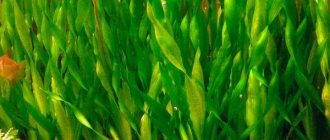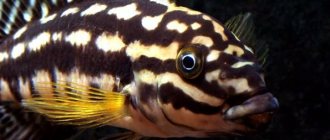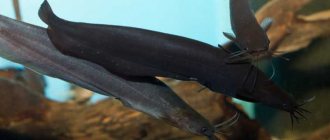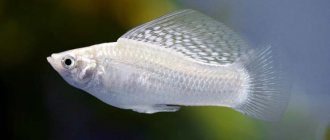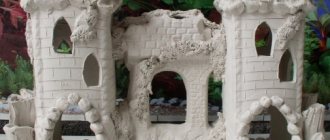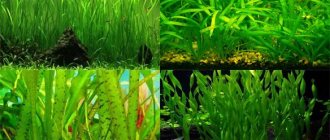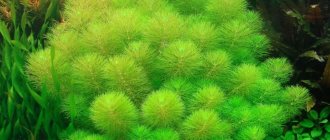03/15/2019Aquarium plants0
Vallisneria is an unpretentious perennial aquarium plant that even a beginner can grow. Caring for her requires a lot of effort and investment. Combines with other algae and will decorate the side or background with its presence.
- 1 Botanical description
- 2 Mr. Tail recommends: types and varieties
- 3 Basics of aquarium farming
- 4 Compatibility
- 5 Reproduction methods
- 6 Uses of Vallisneria
- 7 Possible diseases
general description
The popular aquarium plant looks like a tall bush consisting of ribbon-shaped bright green leaves . Depending on the type, they can be straight or twisted into a spiral.
The length of the leaves varies from 20 cm to 1 meter. They grow from one basal rosette, stretching along the height of the water column. They do not go beyond the surface of the water, lying on it.
To prevent waterlogging, it is recommended to regularly update the planting, removing specimens that have grown greatly in height.
The root system is moderately developed. Long, up to 10 cm, roots allow the bushes to gain a good foothold in the ground.
Under good conditions, Vallisneria can bloom , but its corollas are so small and inconspicuous that they do not add decorative value.
Habitats in nature
Vallisneria can be found on all continents of the Earth. It has adapted to live in stormy rivers, and in stagnant lakes and ponds, and is tolerant of temperature conditions.
On the territory of our country, it has populated the reservoirs of the Ciscaucasia and the Far East ; there are extensive growths of it on the lower Volga.
Conditions of detention
This species has won the love of many aquarists around the world because it adapts well to new conditions. But any aquarium plant, including Vallisneria, needs care. Reaching the surface of the water, the leaves do not stop, but lie along it. Usually Vallisneria grows moderately, but if the algae grow too much and block the access of light to the aquarium, it becomes necessary to shorten them. You should not prune the plant, because if you do this, it will turn yellow and rot, and it will look unnatural. If you are not satisfied with the length, it is better to remove the entire bush.
The root system is moderately developed, and the roots themselves are quite flexible, milky white in color with a slight yellowness. Their length reaches 7-10 cm. This plant should be planted in a small pre-prepared hole. It is advisable to fertilize the soil before planting. The depth is standard - with an open root collar. Vallisneria feeds mainly through the roots. This type of algae can spend quite a long period of time in thin and poor soil, feeding only on fish secretions. But if there are not enough of them in the aquarium, the plant will begin to wither, the growth rate will decrease, and the ends of the leaves will gradually rot. Therefore, do not forget to periodically pamper your beauty with fertilizers. All species of this plant can take complex food. It is best to use fertilizer in the form of a paste or tablets. In addition, it would be a good idea to regularly change some of the water, since a number of nutrients will enter the aquarium along with fresh water. If Vallisneria does not grow, then it begins to be periodically fed with CO2 (Carbon Dioxide).
Popular species among aquarists
The perennial herbaceous plant belongs to the Aquaticaceae family. The first description of the species was made by Carl Linnaeus , and this happened in 1753. He gave it a name in honor of the Italian botanist Antonio Vallisneri. Today the genus is represented by 14 species.
Interesting! The requirements for living conditions are approximately the same for all species. By sticking to averages, you can count on success.
Giant Vallisneria
It is gigantic because its leaves grow 2 meters in length. The width of the leaf blades is 4 cm. This impressive plant also requires spacious aquariums, where it fully reveals its beauty.
The water space looks especially impressive when planting giant Vallisneria along the walls of the aquarium.
Spiral or ordinary
The generic definition of “spiral,” oddly enough, is associated not with the leaves, but with the shape of the peduncle: in female flowers, the stalk of the peduncle is twisted into a spiral.
Vallisneria spiralis is characterized by rapid growth, reaching a length of 40 cm.
Dwarf or nana
The name of this species also has its own paradox. Vallisneria nana is not inferior in growth to other varieties; its leaves stretch up to 60 cm in height.
It is called dwarf for its very narrow leaf blades, painted dark green. Prefers to grow under bright light and temperatures of 25...28 °C.
American
The genus includes two species: narrow-leaved and broad-leaved. The width of the leaves in the first species is 10 mm, in the second - 20–25 mm. The plant is low, up to 20 cm, the leaves are ribbon-shaped, with visible veins. The roots are short but strong.
Tiger
The tiger or spotted (new classification name) has long, up to 60 cm, leaves painted with black strokes. They give the leaves a resemblance to tiger skin.
Nathans
One of the varieties of American Vallisneria with very long, up to 1 meter, leaves. In a small aquarium it adapts to the volume of water and does not grow more than 40–50 cm. The leaves are narrow and thin.
Twisted-leaved
The peculiarity of the species is leaves twisted with a screw. Vallisneria torsionum loses its decorative effect in poor lighting: its leaves become elongated and it becomes similar to its ordinary appearance. Leaf length 40 cm.
Asian
Coming from Japan and some Asian countries, the Asian species is unpretentious in maintenance. Dense bushes stretch 50 cm in height. In bright light, the leaves lose turgor and droop.
Attention! It grows quickly and requires regular thinning.
Is it difficult to maintain?
Keeping Vallisneria in an aquarium is quite simple. She is quite satisfied with the conditions created for tropical fish: warm water, comfortable lighting and a certain water hardness .
Most beginners who turn to aquarium farming for the first time choose this plant for their home pond.
Conditions in the aquarium
If the soil is primarily important for domestic plants, then for aquatic species it is the water parameters. First of all , the water poured into the aquarium must be cleared of salts and impurities that negatively affect the plant.
Most species prefer medium hardness (from 5 to 8 pH). Temperature conditions can vary between 23...32 °C. At 15...18 °C it withers.
In moderate lighting, daylight hours should last at least 8 hours . In winter, its duration is maintained using fluorescent lamps.
View this post on Instagram
Publication from guppi.ru (@guppi.ru) July 27, 2021 at 5:26 PDT
How to plant in an aquarium? Vallisneria bushes are planted in an even row, closer to the filter and the rear walls of the aquarium (can be placed along the side walls).
The water fluctuations caused by the filter straighten the leaves so that they grow properly and look beautiful in an artificial pond.
Attention! When planting, the roots need to be deepened into the soil so that the light part of the rosette remains above it. If you close it, the plant will begin to rot.
How is it useful for an aquarium?
As befits a flora, Vallisneria supplies the aquarium with oxygen . In addition, it is able to neutralize phosphates, nitrates and nitrogenous compounds harmful to fish.
Attention! Rust and copper that get into the aquarium with medicines for fish and during water changes can destroy it.
Do I need to fertilize?
The need for feeding arises if the plant does not have enough nutrients extracted from the soil. If it is of high quality, there is a slight silt, then Vallisneria will grow without problems.
View this post on Instagram
Posted by Arovana (@arovana.aqua) Sep 1, 2021 at 4:05 PDT
A lack of nutritional components is indicated by stopped growth and rotting of leaves . In this case, it is necessary to feed with root fertilizers containing iron and calcium.
Compatibility
Beginners and experienced aquarists combine American and tiger species with algae and shady vegetation. They are planted in tanks containing shellfish, aggressive and peaceful fish phenotypes, shrimp, and cryptocoryne.
But before landing, the optimal location is determined. So, these bushes and cryptocoryne are concentrated near filtration equipment and aerators. After all, this vegetation needs clean water and constant oxygen supply.
Vallisneria is an amazing plant. With its help, conditions are created in the aquarium and other tanks that are necessary for the normal development and reproduction of phenotypes and mollusks. If you control its growth, then other algae and shady plants will develop normally.
Video about the aquarium plant Vallisneria
AdminAuthor of the article
Did you like the article?
Share with your friends:
Why doesn't Vallisneria grow?
When choosing an unpretentious plant for an aquarium, you can sometimes encounter problems. There are several reasons why Vallisneria does not grow in an aquarium:
- incorrect light mode;
- cold water (below 18 °C);
- there is rust and copper in the water;
- incorrectly selected plants for growing together (if Vallisneria’s neighbor has powerful roots, it will take away nutrition);
- water changes are too frequent, or, conversely, too rare;
- unsettled water is poured in.
Name variations
Vallisneria Nana has several spellings. Sometimes a plant is written with one letter "l", but this is a mistake. The most popular variation is Dwarf Vallisneria.
There are also references to Vallisneria Gracilis. Tiger vallisneria is also directly related to nana. This was proven by a DNA test conducted in 2008.
Reproduction and lifespan
The main method of propagation of Vallisneria is vegetative . She herself forms new processes (whiskers) with the rudiments of leaf rosettes. In terrestrial plants, a clear example of vegetative propagation is chlorophytum.
If you notice that the tendril has taken root and has produced several new leaves, carefully cut it from the mother plant with scissors and replant it at a distance of 10 cm.
Vallisneria is a perennial , so you will never be short of material for new plantings.
Diseases, their causes and growing tips
Inappropriate living conditions are the main factor causing diseases. We list possible problems and tell you how to avoid them:
- Vallisneria dissolves in the aquarium . “Cryptocoryne disease” is a consequence of non-compliance with many husbandry parameters. A significant disturbance in the biological balance in the aquarium can lead to such a negative phenomenon.
- Yellowing and dying of leaves occurs due to iron deficiency. Adding 0.1 mg of iron sulfate to the water once a week will correct the situation.
- Blackened leaf tips indicate boron deficiency. To eliminate it, add 0.2 mg/l boric acid.
- Yellowing of the leaf edges is due to a lack of nitrogen. To replenish its quantity, lower the water temperature for several days.
- Do the leaves turn red and the young shoots curl up and darken? This means they lack phosphorus. Fertilizing with phosphorus fertilizer will stop the process.
If the Vallisneria bushes produce dense growth, simply thin them out. Do not cut the leaves under any circumstances: this will destroy the plant.
When decorating an aquarium with Vallisneria, try to maintain optimal conditions for it. This unpretentious perennial will respond to your efforts with lush growth and beautiful forms.
Useful lifehacks
To make Vallisneria Nana pleasing to the eye for as long as possible, we offer you some tips:
- Acquisition. It is advisable to buy bushes from both mother and daughter plants.
- Transportation. It must be transported in a container completely filled with water. Otherwise, the leaves will break against the walls of the tank.
- Landing. The best option is in the water drainage area next to the filter. The current will help to distribute the bushes evenly in the aquarium. Plants can be used as a deterrent for free-floating crops. To do this, you need to lay out the leaves in the shape of small islands. And it is convenient to fix the position with the help of driftwood or leafy plates of Echinodorus.
- Condition of the leaves. If they break, you should pay attention to the water parameters. Vallisneria loves alkaline hard water. Perhaps it has become softer and sour.
- Water quality. Excess copper negatively affects plant development. This element often ends up in the aquarium along with snail preparations and algae control mixtures. Sometimes present in compositions with drugs for the treatment of fish diseases. Vallisneria also reacts negatively to iron oxide. Therefore, owners of frame aquariums with steel corners should be extremely careful and regularly check the water parameters.
